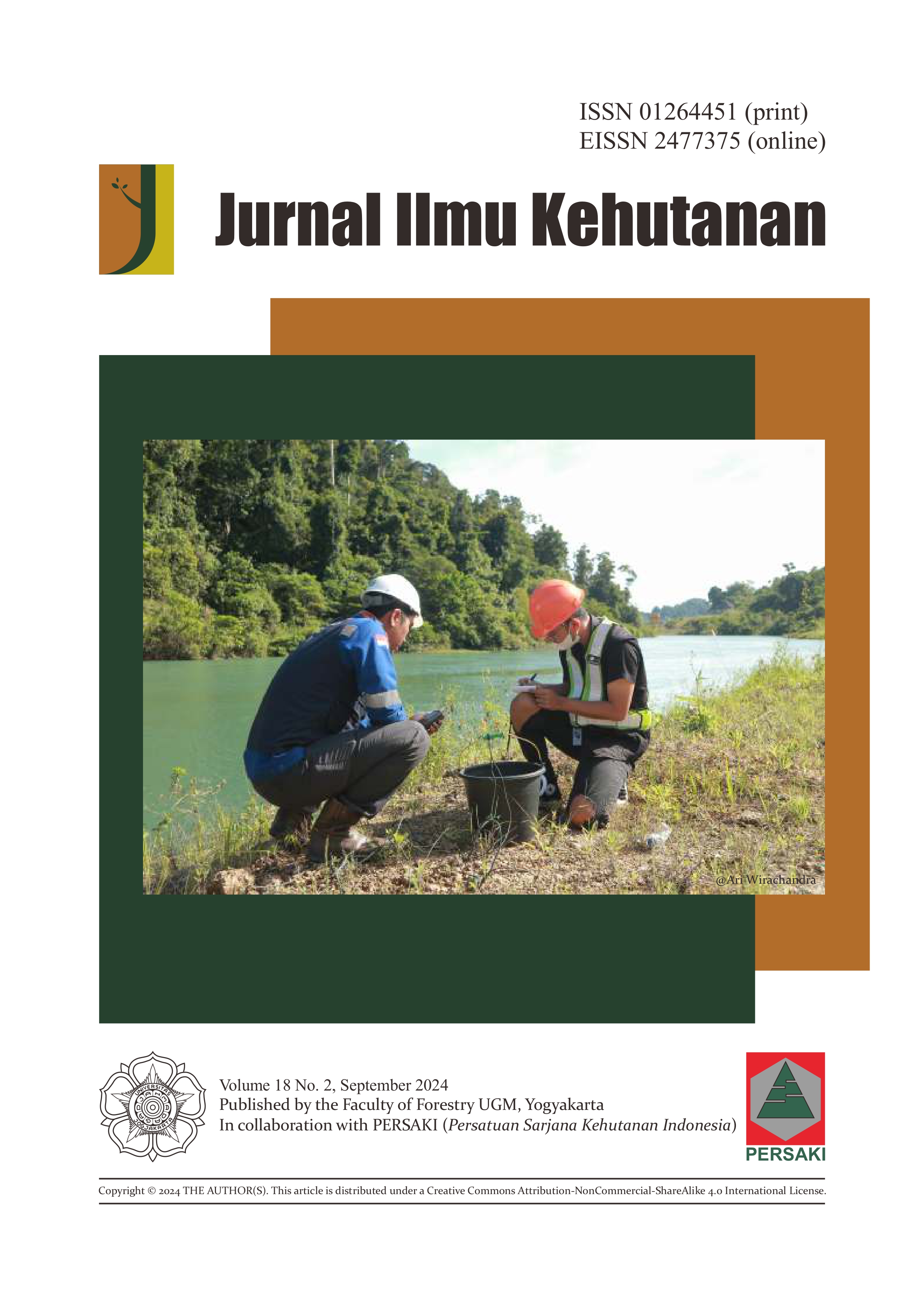Date Log

This work is licensed under a Creative Commons Attribution-NonCommercial-ShareAlike 4.0 International License.
Characteristics of Fast-Growing Wood Impregnated Using Monoethylene Glycol and SiO2 Nanoparticles Against Fungal Attacks
Corresponding Author(s) : Istie Rahayu
Jurnal Ilmu Kehutanan,
Vol 18 No 2 (2024): September
Abstract
Jabon (Anthocephalus cadamba) and Sengon (Falcataria moluccana) were fast-growing wood species widely planted in the community forest. Both kinds of wood have low durability even though they can potentially be used in the carpentry material industry. Therefore, this research aimed to analyze the vacuum-pressure impregnation effect using monoethylene glycol (C2H6O2) or MEG and silica dioxide (SiO2) nanoparticles on wood resistance to fungal decay. The results showed that impregnation treatment with MEG and SiO2 nanoparticles significantly improved the durability of Jabon and Sengon against fungal attacks. Furthermore, MEGSiO2 with 24-hour polymerization had a better impact on durability compared to both the control and MEGSiO2 with 12-hour polymerization. The 24-hour polymerization using 1% SiO2 nanoparticles resulted in the lowest weight loss for Jabon (5.86% ) and Sengon (5.21%). In addition, the variation of SiO2 nanoparticle concentration did not significantly affect the weight loss and durability of Jabon and Sengon against fungal decay.
Keywords
Download Citation
Endnote/Zotero/Mendeley (RIS)BibTeX
- ATSDR (Agency for Toxic Substances and Disease Registry). 2020. Case study in environmental medicine (CSEM): Ethylene glycol and propylene glycol.
- Badi D, Helal A Al, Lagat C, Phan C, Barifcani A. 2020. Evaluation of reboiler temperature retention time on MEG degradation products at varying MEG concentrations. Journal of Petroleum Science and Engineering 196:107735. DOI:10.1016/j.petrol.2020.107735
- Danish Environmental Protection Agency. 2013. Evaluation of health hazards by exposure to Ethylene glycol and proposal of a health-based quality criterion for ambient air.
- Dewi GK, Prayitno TA, Widyorini R. 2024. The effect of wood species and Laminae composition on the properties of cross-laminated beam made from Community Forest Wood. Jurnal Ilmu Kehutanan 18:7179. DOI:10.22146/jik.v18i1.6042.
- Dirna FC, Rahayu I, Zaini LH, Darmawan W, Prihatini E. 2020. Improvement of fast-growing wood species characteristics by MEG and nano SiO2 impregnation. Journal of the Korean Wood Science and Technology 48:4149. DOI:10.5658/WOOD.2020.48.1.41.
- Dong Y, Yan Y, Zhang S, Li J. 2014. Wood/polymer nanocomposites prepared by impregnation with furfuryl alcohol and Nano-SiO2. BioResources 9:60286040. DOI:10.15376/biores.9.4.6028-6040.
- Elustondo D, Matan N, Langrish T, Pang S. 2023. Advances in wood drying research and development. Drying Technology 41:890914. DOI:10.1080/07373937.2023.2205530
- Fowles J, Banton M, Klapacz J, Shen H. 2017. A Toxicological review of the Ethylene glycol series: commonalities and differences in toxicity and modes of action. Toxicology Letters 278:66-83.
- Fufa SM, Hovde PJ. 2010. Nano-based modifications of wood and their environmental impact: Review. 11th World Conference on Timber Engineering 2010, WCTE 2010 3:23872388. DOI:10.1016/j.toxlet.2017.06.009
- Ghosh SC, Militz H, Mai C. 2008. Decay resistance of treated wood with functionalised commercial silicones. BioResources 3:13031314. DOI:10.15376/biores.3.4.1303-1314
- Ghosh SC, Militz H, Mai C. 2009. The efficacy of commercial silicones against blue stain and mould fungi in wood. European Journal of Wood and Wood Products 67:159167. DOI: 10.1007/s00107-008-0296-7.
- Hadiyawarman H, Rijal A, Nuryadin BW, Abdullah M, Khairurrijal K. 2008. Fabrikasi material nanokomposit superkuat, ringan dan transparan menggunakan metode simple mixing. Jurnal Nanosains & Nanoteknologi 1:1421.
- Hair, J F, W C Black, B J Babin, and R E Anderson. 2013. Multivariate Data Analysis. Pearson Education Limited. https://books.google.co.id/books?id=VvXZnQEACAAJ.
- Haque ME, Tripathi N, Palanki S, Xu Q, Nigam KDP. 2022. Plant-wide modeling and economic analysis of monoethylene glycol production. Processes 10. DOI: 10.3390/pr10091755
- Hill CAS. 2006. Wood modification: Chemical, thermal, and other processes. John Willey and Sons Ltd., West Sussex (UK).
- Islam MA, Hadadi N, Ataman M, Hatzimanikatis V, Stephanopoulos G. 2017. Exploring biochemical pathways for mono-ethylene glycol (MEG) synthesis from synthesis gas. Metabolic Engineering 41:173181. DOI:10.1016/j.ymben.2017.04.005.
- Kirker GT. 2018. Wood Decay Fungi. Pages 16 eLS. John Wiley & Sons, Ltd: Chichester.
- Kusumaningsih KR. 2017. Absorption property of preservative on several building woods. Jurnal Wana Tropika 1:1625.
- Martawijaya A, Hadjodarsono S, Haji M. 2005. Atlas Kayu Indonesia Jilid II. Pusat Penelitian dan Pengembangan Hutan dan Konservasi Alam, Bogor (ID).
- Martha R, Mubarok M, Batubara I, Rahayu IS, Setiono L, Darmawan W, Christine G, Philippe G. 2021. Effect of furfurylation treatment on technological properties of short rotation teak wood. Journal of Materials Research and Technology 12:16891699. DOI:10.1016/j.jmrt.2021.03.092.
- Prihatini E, Wahyuningtyas I, Rahayu IS, Ismail R. 2023. Pengaruh larutan furfuril alkohol dan nanopartikel SiO2 pada beberapa metode impregnasi kayu jabon. Indonesian Journal of Laboratory 6:713. DOI: 10.22146/ijl.v0i3.84108.
- Rahayu I, Darmawan W, Nawawi DS, Prihatini E, Ismail R, Laksono GD. 2022. Physical properties of fast-growing wood-polymer nano composite synthesized through TiO2 nanoparticle impregnation. Polymers 14. DOI:10.3390/polym14204463
- Rahayu I, Darmawan W, Zaini LH, Prihatini E. 2020. Characteristics of fast-growing wood impregnated with nanoparticles. Journal of Forestry Research 31:677685. DOI:10.1007/s11676-019-00902-3.
- Rahayu I, Pratama A, Darmawan W, Nandika D, Prihatini E. 2021a. Characteristics of impregnated wood by nano silica from betung bamboo leaves. IOP Conf. Series: Earth and Environmental Science 891:012019.
- Rahayu I, Wahyuningtyas I, Zaini L, Darmawan W, Maddu A, Prihatini E. 2021b. Physical properties of impregnated ganitri wood by furfuryl alcohol and nano-SiO2. IOP Conference Series: Earth and Environmental Science 891:012012.
- Sandberg D, Kutnar A, Mantanis G. 2017. Wood modification technologies - A review. IForest 10:895908.
- SNI 01-7207. 2006. SNI 01-7207-2006: Uji ketahanan kayu dan produk kayu terhadap organisme perusak kayu. Page Badan Standardisasi Nasional (BSN). Available from https://app.box.com/shared/o9zofikn44cgjpjxqu6m.
- Stange S, Wagenführ A. 2022. 70 years of wood modification with fungi. Fungal Biology and Biotechnology:16. BioMed Central.
- Teng TJ, Arip MNM, Sudesh K, Nemoikina A, Jalaludin Z, Ng EP, Lee HL. 2018. Conventional technology and nanotechnology in wood preservation: A review. BioResources 13:92209252. DOI:10.15376/biores.13.4.Teng
- Wahyuningtyas I, Rahayu IS, Maddu A, Prihatini E. 2022. Magnetic properties of wood treated with nanomagnetite and furfuryl alcohol impregnation. BioResources 17:64966510. DOI:10.15376/biores.17.4.6496-6510
